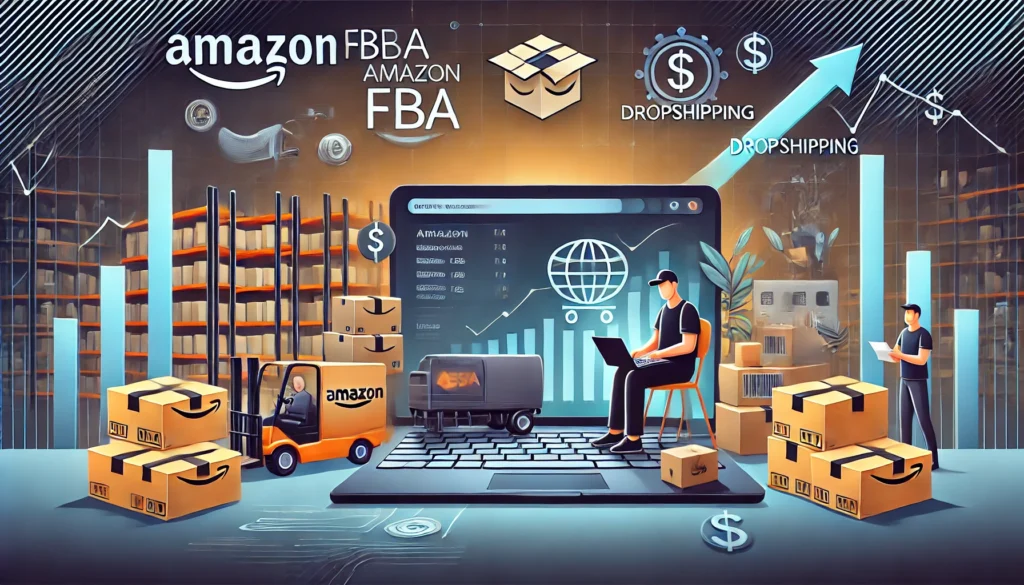
In the world of eCommerce, two popular business models often come up in discussions: Amazon FBA (Fulfillment by Amazon) and Dropshipping. Both offer unique advantages and challenges, but the key question remains—which one is more profitable? Therefore, let’s break down the differences, costs, and potential profits of each to help you make an informed decision.
What Is Amazon FBA?
Amazon FBA allows sellers to store their inventory in Amazon’s fulfillment centers. As a result, Amazon takes care of storage, packaging, and shipping on behalf of the seller. This model is ideal for those who want to leverage Amazon’s massive customer base and enjoy streamlined logistics.
Pros of Amazon FBA:
- Access to Amazon Prime customers, thereby increasing sales potential.
- Amazon handles shipping, customer service, and returns, which reduces operational burden.
- Faster shipping times compared to dropshipping, leading to a better customer experience.
- Higher profit margins on private-label products, thus increasing revenue potential.
Cons of Amazon FBA:
- Upfront investment required for inventory, which can be a financial hurdle.
- Storage fees and other fulfillment costs may add up over time.
- Strict Amazon policies and potential account suspensions can pose risks.
- Amazon FBA Official Page
https://sell.amazon.com/fulfillment-by-amazon
Amazon’s official guide to FBA, including fees, storage, and logistics.
What Is Dropshipping?
Dropshipping is a retail fulfillment method where the seller does not keep products in stock. Instead, when a store sells a product, it purchases the item from a third party (usually a wholesaler or manufacturer) who then ships it directly to the customer. Consequently, this model eliminates the need for inventory management.
Pros of Dropshipping:
- Low startup costs—no need to buy inventory upfront, making it accessible for new entrepreneurs.
- No need to manage warehousing, shipping, or returns, thereby simplifying logistics.
- Wide product variety and the ability to test products easily, which makes it flexible.
- Lower financial risk compared to FBA, reducing potential losses.
Cons of Dropshipping:
- Lower profit margins due to supplier costs, making it harder to scale profitably.
- Shipping times can be long, especially from overseas suppliers, which may frustrate customers.
- High competition and reliance on suppliers for product quality, leading to possible inconsistencies.
- Customer service challenges, including handling returns and refunds, which can be time-consuming.
Profitability Comparison: Amazon FBA vs. Dropshipping
1. Upfront Investment & Costs
- Amazon FBA: Requires an initial investment in inventory, storage fees, and fulfillment fees. However, these costs may be offset by higher sales potential.
- Dropshipping: No upfront inventory costs, but suppliers may have higher product prices, reducing margins. Therefore, pricing strategies must be carefully considered.
2. Profit Margins
- Amazon FBA: Typically offers higher profit margins (20-50%) due to the ability to brand and set competitive prices. Consequently, this can lead to greater financial stability.
- Dropshipping: Lower profit margins (10-30%) since sellers rely on third-party suppliers, which makes it harder to generate substantial profits quickly.
3. Scalability
- Amazon FBA: Easier to scale with Amazon’s infrastructure handling logistics. This advantage allows sellers to grow their businesses more efficiently.
- Dropshipping: More challenging to scale due to supplier dependency and lower margins. As a result, long-term growth may require additional marketing investments.
4. Customer Experience
- Amazon FBA: Faster shipping times and reliable fulfillment improve customer satisfaction, which can lead to higher repeat purchases.
- Dropshipping: Longer delivery times and quality control issues can lead to negative reviews, thereby impacting brand reputation.
Which Model Should You Choose?
- If you have capital to invest and want a long-term brand-building strategy, Amazon FBA may be more profitable. Additionally, it offers better scalability and customer experience.
- If you want to start with minimal risk and test different products quickly, dropshipping can be a better choice. However, you must be prepared for lower profit margins.
For those considering Amazon FBA, you can explore Amazon’s Seller Central for more details. Similarly, if you’re interested in dropshipping, platforms like Shopify offer tools to get started.
Both models have the potential to be profitable, but success depends on your budget, risk tolerance, and long-term business goals. Which model are you considering? Let us know in the comments!
